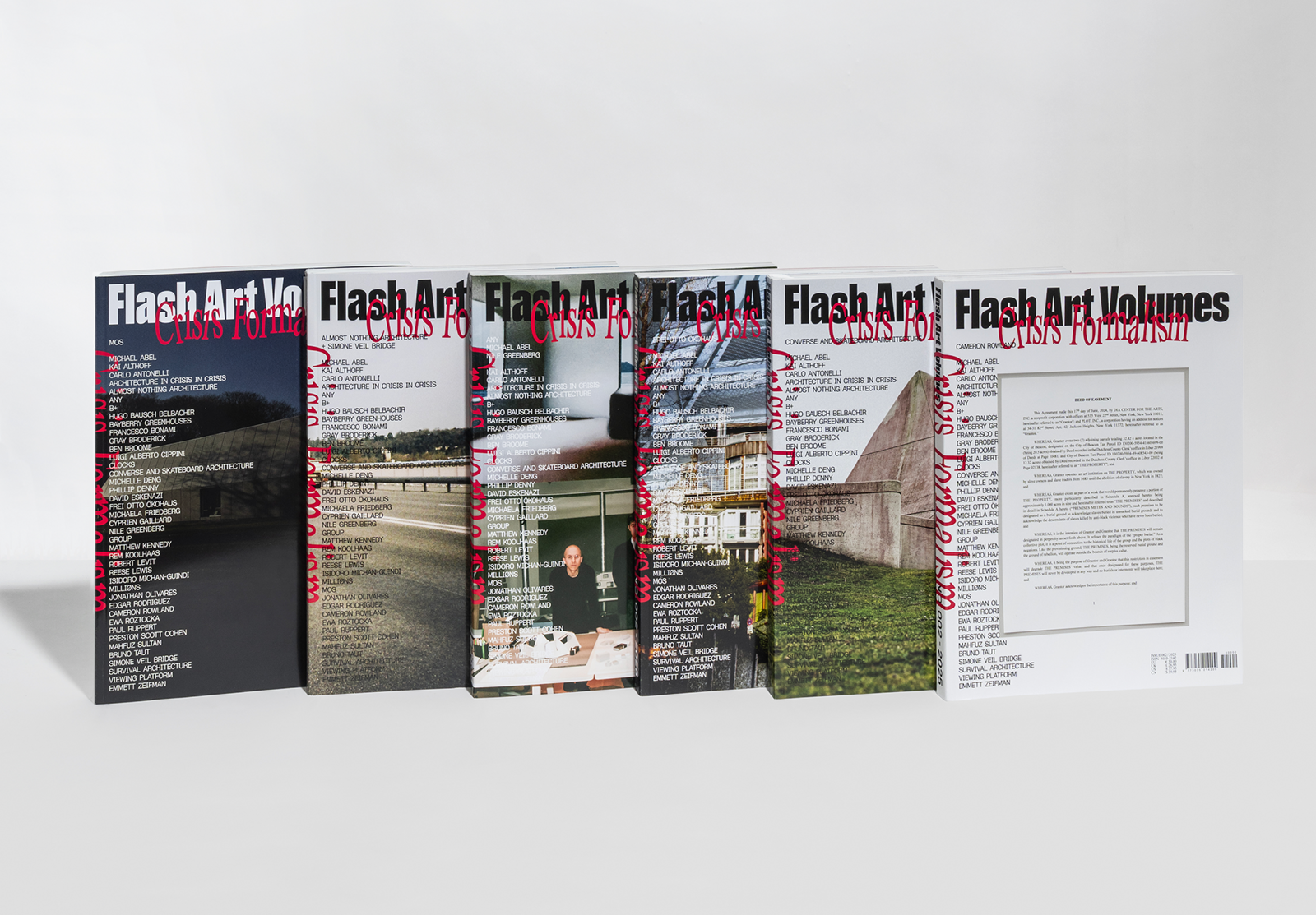Vol. 002: Crisis Formalism
Launched in 2024, Flash Art Volumes explores broad themes spanning architecture, design, and art publication. Positioned as a fresh vantage on these subjects, it integrates economic perspectives, theoretical analyses, and market considerations to redefine content relationships and assert itself as a conduit of value. Its approach amplifies intention, setting a distinct tone within the discourse.
For its second issue, Flash Art Volumes invited Michael Abel and Nile Greenberg of the New York–based architecture practice ANY as guest editors. They have titled this edition “Crisis Formalism.”
“Volumes progresses with its latest edition, delving into the pressing circumstances we currently face: the polycrisis and its impact on architecture, particularly examining the unbalanced and often unspoken geopolitical factors at play,” notes Gea Politi, Flash Art’s editor-in-chief.
If we recognize that architecture is at a tipping point—in which form, once immediate and vital, risks dissolving into a haze of proliferating crises—then the moment calls for a fundamental rethinking of form itself, not as an outcome of crisis but as its very cause. Crisis has long unsettled architecture: modernists, postmodernists, deconstructivists, and parametricists each declared a state of emergency in which the discipline faltered. Still, a recurring twentieth-century question remains: can architecture act politically in response to crisis—whether in housing, civic identity, or technological shifts?
Today’s crises, however, are entangled in broader complexities. The contemporary world is defined by what French philosopher Edgar Morin termed “polycrisis”—a web of interlinked emergencies that confound both institutional structures and inherited architectural frameworks. Whereas architecture once aspired to generate stable meaning, today’s swirl of economic, environmental, and political disruptions has undermined that assumption. In response, some retreat from architecture into policy, finance, or material logistics. Yet, rather than diminishing architecture’s cultural potency, these challenges invite a renewed engagement with form.
“Crisis Formalism” proposes that form—often reduced to mere aesthetic expression—can become the site where crisis is contained, concentrated, and transformed into new architectural possibilities. What, then, are the formal implications of crisis?
Historically, crises have shaped architectural forms in profound ways. Consider the Kaiping Diaolou in Guangdong, China: a network of more than 1,800 fortified towers that emerged from intersecting crises—bandit raids, seasonal food shortages, forced migration, economic upheaval, and cross-cultural exchanges. Built between 1900 and 1931, these structures combined defensive features (fortified walls, elevated entries) with Western stylistic influences, reflecting the hybrid identities of returning Chinese laborers who had faced exclusionary policies abroad. These structures embodied crisis as an architectural force, demonstrating how multiple disruptions converse to generate new forms.
Alessio Avventuroso, creative director of Flash Art, reinforces this perspective: “‘Crisis Formalism’ is a creative position which holds that an artwork’s value lies in the relationships it establishes between different compositional elements. Abel and Greenberg select and engage with different profiles across the world to bring diverse perspectives to difficult questions, reminding all of us that we are living in interesting times.”
“Crisis Formalism” stands on a dual premise: first, that architectural form has lost its immediacy and resonance; second, that contemporary crises require more than reactive solutions. If architects address crises in isolation—whether geopolitical, financial, or environmental—designs unravel under the weight of their interdependencies. Morin warns that fragmented, reductionist thinking produces a blindness that leaves architecture complicit in the very crises it seeks to mitigate.
A historical parallel emerges in Paul Valéry’s Crisis of the Mind (1919), which argued that intellectual crises demanded aesthetic reinvention. Likewise, contemporary architecture faces urgent dilemmas: climate catastrophe, economic inequities, unregulated capital expansion. The question is not merely how architecture responds, but how it is embedded within these crises. “Crisis Formalism” asserts that form must emerge from crisis, rather than attempt to resolve it.
Traditional tactics—dystopian collages, utopian visions, ironic subversions—have been co-opted into market cycles, their radical edge dulled. Instead, “Crisis Formalism” engages with failure, contradiction, and instability, treating form as an active site of social and political friction. Architecture, in this context, becomes a field of antagonism rather than resolution.
One compelling example is Elizabeth Diller and Riccardo Scofidio’s Viewing Platform, constructed after 9/11 from scaffolding and plywood. More than a designed memorial, the structure facilitated public mourning, acting as a raw, temporary conduit for collective grief. Its impact lay not in symbolic permanence but in its ability to metabolize crisis in real time.
In compiling this volume, we have sought projects that do not merely react to crisis but employ forms as a means of navigating their complexities. Sections such as Crazy Spirit, Form Follows Forces, Dada Deacon, and Collapse explore how economic pressures, ecological instability, and social upheaval manifest architecturally. These approaches do not offer closure; rather, they acknowledge that crisis and form are inseparable.
If illusions of stable progress have collapsed, then architecture must embrace new formal strategies that confront instability head-on. “Crisis Formalism” proposes that architecture, rather than retreating, must assert its political and representational potency by engaging with the crises that define our era. The question remains: What are the formal implications of crisis?
This issue will premiere during Milan Design Week, April 8–13, 2025.

